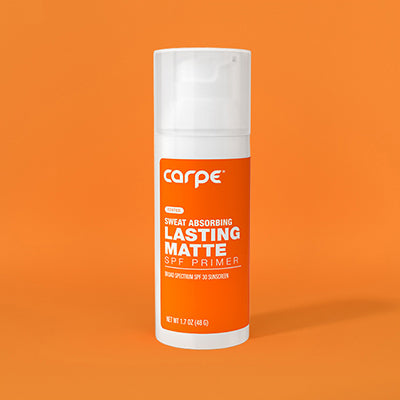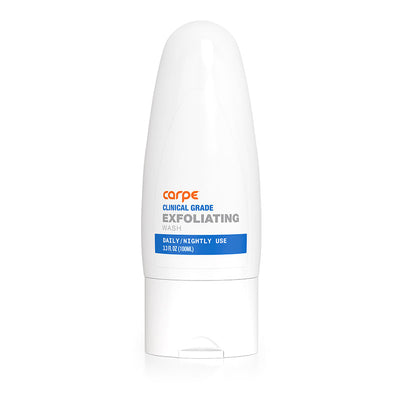Have you been wondering: what are night sweats? We’ve got you covered! Keep reading to find out more about night sweats and what you can do to stop them.
Night sweating refers to excessive sweating that occurs at night while a person sleeps. This kind of sweating happens in the absence of any environmental stimuli that would normally trigger sweating (like hot temperature). Usually, it causes all-over body sweating. It can get so bad that it causes some people to soak through clothes and bedsheets![1]
Night sweats are usually a symptom associated with secondary hyperhidrosis, or diaphoresis - unexplained excessive sweating. This is a type of hyperhidrosis that causes excessive sweating due to specific biological factors like illness, drugs, or hormonal states.[2]
Many times, night sweats are a common symptom and pose no reason for concern, but in some cases they may be a signal of a larger problem. It is important to know when to be concerned about night sweats. If you suddenly begin experiencing night sweats or are having other health issues in conjunction with them, then you shouldmanage your hyperhidrosis with a dermatologist or other qualified doctor. Otherwise, there are many effective tools you can use to learn how to stop your night sweats and find relief.
Causes of Night Sweats
There are many possible diseases and conditions that cause secondary hyperhidrosis, and subsequently night sweating. Often, one of the most common causes of night sweats are side effects of medication or drugs.[2] Below is an in-depth look at the possible causes of night sweats.
Medications and Drugs that Cause Night Sweating
There is a long list of common medicine that cause hyperhidrosis and any of these medications have the potential to also induce night sweats.[2]
Of the drugs that can cause secondary hyperhidrosis antidepressants seems to be the most common cause of night sweating. One meta analysis found that between 10% and 14% of those on SSRIs, a very common antidepressant, suffer from night sweating.[3]
Here is a brief break-down of the types of medications that can cause secondary hyperhidrosis as well as night sweating:
- Pain medications: many types of opiates, NSAIDs (which are over the counter anti-inflammatories) and marinol (cannabinoid medication)
- Psychiatric medications: antidepressants, antipsychotics, anxiolytics and ADHD medications
- Hormonal medications: birth control and other medications containing estrogen or testosterone
- Diabetes medication[2]
There are many other medications that can cause secondary hyperhidrosis, which in turn leads to night sweating. Those listed above are just the most common types. So, if you believe a medication may be the reason you are sweating at night then it would be prudent to look at a comprehensive list and determine if your medication may be to blame.[2]
It should also be known that drug intoxication or withdrawal has the potential to cause night sweating, especially withdrawal from alcohol.[4] If the onset of night sweats is concurrent with the cessation of drug use this cause should be considered.
Menopause
Menopause is a notorious cause of night sweats and hot flashes. It usually begins in a woman’s 40’s. It is a hormonal change that indicates a woman is at the end of her childbearing years. Up to 80% of women going through menopause will suffer from night sweats and hot flashes at some point, so it is extremely common.
There are blood tests that can be done to determine whether a woman is going through menopause and it is advisable to have one done to determine whether it is the cause of night sweats.[5] One study published in the journal Climacteric studied menopausal women from various cultures and it showed that night sweats and hot flashes are a shared physiological phenomenon experienced by women all over the world.[6]
Illness
Several illnesses are known to cause night sweating. In some cases, these are short-term illnesses that produce a fever and will go away without intervention in a short period of time. Many times a short-lived fever can be responsible for temporary night sweats.[7]
Other times, night sweating can indicate a more serious condition, especially if night sweats are ongoing. This is when to be concerned about night sweats. Some cancers, especially lymphoma, can have night sweating as an initial symptom. This is more likely if there has also been unintended weight loss occurring at the same time as the onset of night sweats. Another potentially serious cause of night sweating is Tuberculosis, a serious lung infection. If night sweats have been occurring for a long period of time and are accompanied by weight loss, long-term fevers, enlarged spleen and lymph nodes, then immediate action needs to be taken to ensure that the sweating is not being caused by a serious medical condition.[4]
There are several other diseases and conditions that can cause secondary hyperhidrosis and night sweats including certain neurological disorders, hormonal conditions, hypoglycemia, and other serious infections.[1] It is important to explore all of the possible causes and discuss your night sweats with a doctor if they are ongoing and disruptive.
It is also important to point out that in some cases, anxiety can cause night sweats to occur. If this is the case, then addressing the cause of the anxiety or treating the anxiety should help to improve symptoms.[8] Other physiological conditions should be ruled out before anxiety can be deemed as a causative factor. Anxiety which causes night sweats can lead to chronic insomnia so it is important to get address the issues as quickly as possible.
Night Sweats in Children
Night sweating can occur in children. One study published in the Archives for Disease in Childhood found that night sweats were most commonly seen in children suffering from eye, respiratory, or atopic diseases. It was also found that these children were more likely to suffer from other sleep related disruptions. Boys tended to have a higher occurrence of sweating than girls.[9]
If a child is suffering from night sweats there are ways to help kids with hyperhidrosis. It is important to have them checked by a doctor to make sure that there is no serious underlying condition and there are medical treatments available to kids with hyperhidrosis if night sweats are severe.
How to Stop Night Sweats
There are several ways doctors know how to stop night sweats. However, the most effective treatment for night sweating is to determine the underlying cause and correct it. This is because night sweats are a symptom of secondary hyperhidrosis, and as such, are most frequently a symptom of another condition.[2]
If night sweats are something a person will be dealing with for a prolonged time, taking measures to manage hyperhidrosis at home are a good next step. Try some of these natural remedies to stop night sweats:
- Take a cool shower before bed
- Keep the bedroom temperature low
- Change bedding often
- Turn your pillow over after sweating
- Dress in layers so you can take clothes off easily
- Use a bedside fan
- Avoid triggers like caffeine, alcohol, and spicy foods before bed
- Use new pajamas every night, and have a clean set by your bedside in case they are needed in the middle of the night.[10]
How to Stop Night Sweats with Medical Treatments
If natural treatments are not enough, patients can learn how to stop night sweats by using antiperspirant and topical creams to reduce sweating. These typically use a combination of aluminum and other ingredients to prevent excessive sweating at the sweat gland. They are most effective when used on dry skin and applied at night to allow the formulation to sink in.[2]
Finally, if a patient cannot fix the root cause of their night sweats, there are oral medications that can prevent systemic sweating. The most common class of medications used to do this are called anticholinergics. They are not without side effects but can be of great help to patients who may otherwise be unable to get proper rest. There are other medications available, but anticholinergics are typically the most effective in this case.[2]
If you are experiencing night sweats due to menopause then there are several things you can try to reduce your symptoms. Eating a proper diet can improve symptoms as well as reducing substances like caffeine, spicy foods, and alcohol.[11] Women can also try hormonal medications to reduce the side effects of menopause and ease the stress of excessive sweating.
Now, when you wonder “what are night sweats?” you know the answer - they are a symptom of something else. Overall, stress reduction, a healthy lifestyle and figuring out the cause of your excessive sweating can greatly improve, and even stop night sweats. So, don’t give up and speak to your doctor!
Sources
- 8 Causes of Night Sweats. (n.d.). Retrieved August, 2018, from https://www.webmd.com/menopause/guide/8-causes-of-night-sweats
- Pariser, D. M. (2014). Hyperhidrosis (4th ed., Vol. 32). Amsterdam: Elsevier Pub. Co., 2014. Retrieved from https://www.elsevier.com/books/hyperhidrosis-an-issue-of-dermatologic-clinics/pariser/978-0-323-32607-0
- Giudice, M. (2006). Tracing night sweats to drug can be challenging. . Canadian Pharmacists Journal, 139(1), 59-60. Retrieved August 27, 2018, from https://www.researchgate.net/publication/292841542_Tracing_night_sweats_to_drug_can_be_challenging
- Greenham, A. (2011). Night sweats. GP, 34-35. Retrieved August 27, 2018, from http://ezproxy.co.wake.nc.us/login?url=https://search.proquest.com/docview/883399774?accountid=14867
- Paisly, A. N., & Buckler, H. M. (2010). Investigating secondary hyperhidrosis. BMJ : British Medical Journal (Online), 341. doi:10.1136/bmj.c4475 Retrieved from https://www.bmj.com/content/341/bmj.c4475.full
- Freeman, E. W., & K. S. (2007). Prevalence of hot flushes and night sweats around the world: A systematic review. Climacteric, 10(3), 197-214. Retrieved August 27, 2018, from https://pubmed.ncbi.nlm.nih.gov/17487647/
- Bishop, S. (2010). For Vast Majority, Night Sweats Don’t Represent Medical Concern. Retrieved August, 2018, from https://newsnetwork.mayoclinic.org/discussion/for-vast-majority-night-sweats-dont-represent-medical-concern/
- What Causes Night Sweats? (2018). Retrieved August, 2018, from https://www.webmd.com/a-to-z-guides/ss/slideshow-night-sweats
- So, H. K., Li, A. M., Au, C. T., Zhang, J., & Lau, J. (2012). Night sweats in children: Prevalence and associated factors. Archives of Disease in Childhood, 97(5). doi:10.1136/adc.2010.199638 Retrieved from https://pubmed.ncbi.nlm.nih.gov/21427123/
- Dealing with Menopausal Hot Flashes and Night Sweats. (n.d.). Retrieved August, 2018, from https://www.healthline.com/health/menopause/hot-flashes-at-night
- AntiAging Institute of California; How to Overcome Menopause Hot Flashes, Night Sweats and Other Symptoms. (2014). Pain & Central Nervous System Week. Retrieved August 27, 2018, from https://search-proquest-com.proxy187.nclive.org/docview/1476527644?pq-origsite=summon
16764909816681.jpg?v=1676490983)



16790753702383.jpg?v=1679075372)

16790746985853.jpg?v=1679074700)


16790757289763.jpg?v=1679075731)









